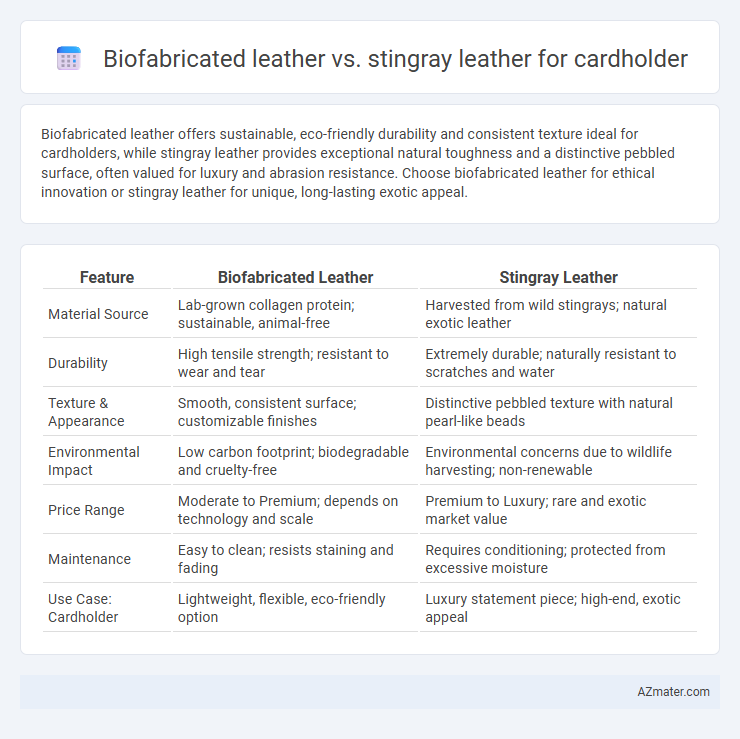Biofabricated leather offers sustainable, eco-friendly durability and consistent texture ideal for cardholders, while stingray leather provides exceptional natural toughness and a distinctive pebbled surface, often valued for luxury and abrasion resistance. Choose biofabricated leather for ethical innovation or stingray leather for unique, long-lasting exotic appeal.
Table of Comparison
| Feature | Biofabricated Leather | Stingray Leather |
|---|---|---|
| Material Source | Lab-grown collagen protein; sustainable, animal-free | Harvested from wild stingrays; natural exotic leather |
| Durability | High tensile strength; resistant to wear and tear | Extremely durable; naturally resistant to scratches and water |
| Texture & Appearance | Smooth, consistent surface; customizable finishes | Distinctive pebbled texture with natural pearl-like beads |
| Environmental Impact | Low carbon footprint; biodegradable and cruelty-free | Environmental concerns due to wildlife harvesting; non-renewable |
| Price Range | Moderate to Premium; depends on technology and scale | Premium to Luxury; rare and exotic market value |
| Maintenance | Easy to clean; resists staining and fading | Requires conditioning; protected from excessive moisture |
| Use Case: Cardholder | Lightweight, flexible, eco-friendly option | Luxury statement piece; high-end, exotic appeal |
Introduction: The Rise of Alternative Leathers in Cardholder Fashion
Biofabricated leather represents a sustainable innovation in cardholder fashion by offering cruelty-free, eco-conscious alternatives to traditional materials. Stingray leather remains prized for its natural durability, unique texture, and water resistance, appealing to luxury markets. The emergence of biofabricated leather challenges conventional luxury norms by combining ethical production with customizable aesthetics, reshaping consumer preferences in the leather goods sector.
Biofabricated Leather: Definition and Manufacturing Process
Biofabricated leather, created through advanced biotechnology, replicates traditional leather properties using cultured animal cells without harvesting from animals. The manufacturing process involves growing collagen fibers in controlled environments, which are then structured and treated to mimic the texture, durability, and flexibility of natural leather, making it a sustainable alternative to stingray leather. This method reduces environmental impact by minimizing water usage, chemical treatments, and ethical concerns commonly associated with stingray leather production.
Stingray Leather: Unique Characteristics and Sourcing
Stingray leather is renowned for its distinctive texture, featuring a natural pebble-like surface and a durable, water-resistant quality that makes it ideal for high-end cardholders. Its unique composition includes calcium-rich calcified nodules that provide exceptional strength and a shimmering appearance, setting it apart from biofabricated leather options. Sourced primarily from sustainable fisheries in Southeast Asia, stingray leather undergoes meticulous tanning processes to preserve its natural pattern and ensure long-lasting performance.
Durability Comparison: Biofabricated vs Stingray Leather
Biofabricated leather offers high durability through engineered molecular structures that resist scratches and wear, maintaining flexibility over prolonged use. Stingray leather is renowned for its exceptional toughness and resistance to abrasion due to natural calcification, making it extremely durable for everyday wear. Compared side-by-side, stingray leather provides superior abrasion resistance, while biofabricated leather excels in consistent quality and eco-friendly resilience without compromising durability.
Aesthetic Appeal and Texture Differences
Biofabricated leather offers a smooth, consistent texture with a modern, sleek aesthetic, making it ideal for minimalist cardholder designs. Stingray leather features a distinctive pebbled surface with a natural pearlescent sheen, providing a luxurious and exotic appearance prized in high-end accessories. The tactile contrast lies in biofabricated leather's uniform softness versus stingray's textured, durable feel, catering to different style preferences and sensory experiences.
Sustainability and Environmental Impact
Biofabricated leather offers a sustainable alternative to stingray leather by utilizing lab-grown materials that significantly reduce resource consumption and eliminate the need for animal harvesting. Stingray leather, while durable and water-resistant, involves ecological challenges such as overfishing and habitat disruption, negatively impacting marine biodiversity. Choosing biofabricated leather for cardholders minimizes carbon footprint and supports ethical production practices, making it an environmentally responsible option.
Ethical Considerations: Animal Welfare and Vegan Options
Biofabricated leather offers a cruelty-free alternative to stingray leather by eliminating the need for animal harvesting, aligning with ethical commitments to animal welfare and supporting vegan lifestyles. Stingray leather, while durable and unique in texture, involves harvesting from wild or farmed stingrays, raising concerns about marine ecosystem impact and animal rights. Choosing biofabricated leather supports sustainable innovation and reduces reliance on marine wildlife, appealing to ethically conscious consumers seeking cruelty-free and vegan products.
Cost Analysis: Pricing and Accessibility
Biofabricated leather for cardholders presents a competitive cost advantage with scalable production methods that reduce material expenses and environmental costs compared to stingray leather, which remains a premium, high-priced material due to labor-intensive harvesting and limited supply. Stingray leather's durability and unique texture justify its higher market price, often ranging from $150 to $300 per cardholder, whereas biofabricated leather can cost between $70 and $150, improving accessibility for a broader consumer base. The cost-efficiency of biofabricated leather enhances its appeal in sustainable fashion markets, offering an affordable luxury alternative without sacrificing quality or aesthetic appeal.
Maintenance and Longevity for Daily Use
Biofabricated leather offers exceptional durability and requires minimal maintenance, resisting stains and water damage, making it ideal for daily use in cardholders. Stingray leather is highly durable and naturally water-resistant but needs occasional conditioning to maintain its unique texture and avoid drying out over time. While both materials provide longevity, biofabricated leather demands less upkeep, ensuring consistent appearance and functionality with minimal effort.
Which Leather is Best for Cardholder Applications?
Biofabricated leather offers a sustainable and cruelty-free alternative to stingray leather, combining durability and flexibility ideal for cardholders. Stingray leather is prized for its distinctive texture and exceptional toughness, making it highly resistant to scratches and wear. For cardholder applications, biofabricated leather excels in eco-friendliness and consistent quality, while stingray leather provides unmatched luxury and longevity.

Infographic: Biofabricated leather vs Stingray leather for Cardholder
 azmater.com
azmater.com